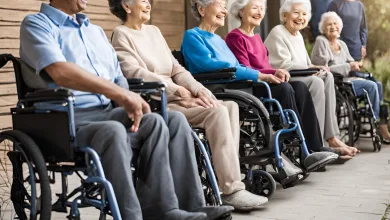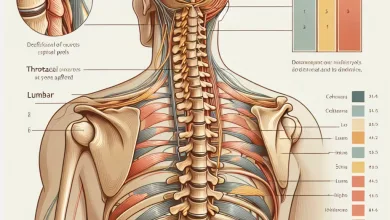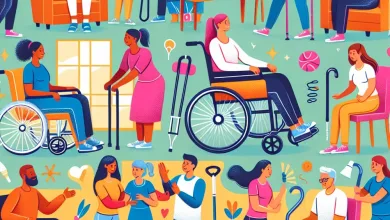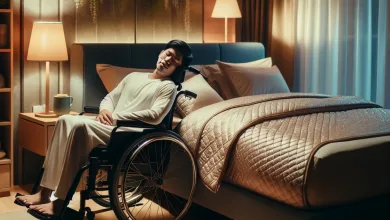How to Boost Rehabilitation with Standing Power Chairs for Physical Therapy
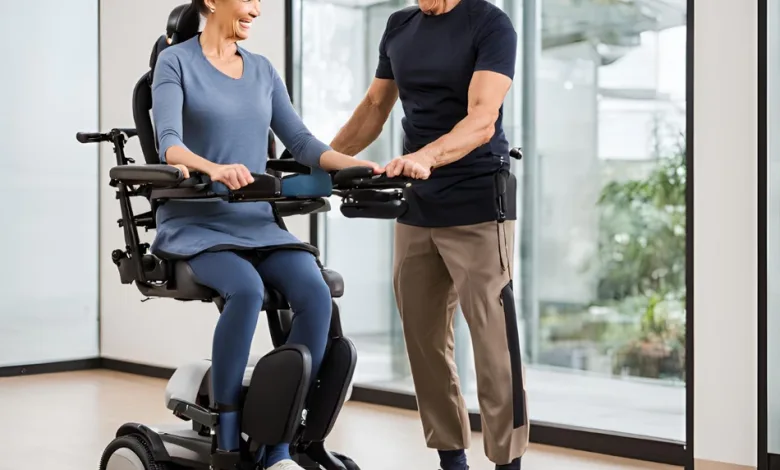
Table of Contents
Unlock Effective Recovery with Standing Power Chairs
Rehabilitation can be a complex journey, especially for individuals with mobility challenges. However, Rehabilitation with Standing Power Chairs is revolutionising the process, offering significant benefits in physical therapy recovery. Explore how these innovative mobility devices contribute to improved outcomes and overall well-being.
How Standing Power Chairs Can Revolutionise Your Physical Therapy Journey
Imagine a world where rehabilitation feels empowering, not just challenging. Enter standing power chairs, a revolutionary mobility device transforming physical therapy for individuals with mobility limitations. These advanced mobility technology wonders go beyond getting you from point A to point B. They actively support physical therapy recovery by incorporating weight-bearing positions into your daily routine.
Standing power chairs empower users by allowing them to stand up and move freely, which is a significant psychological boost. Standing tall and interacting with others at eye level can significantly improve self-esteem and social interactions, leading to better psychological well-being. This empowerment translates to a more positive outlook on the rehabilitation process, making it feel less like a chore and more like a series of achievable goals.
These chairs also transform physical therapy by making it more dynamic and inclusive. Traditional physical therapy often involves static exercises performed while seated or lying down. Standing power chairs change the game by allowing users to engage in weight-bearing positions, which are crucial for:
- Improving bone density: Weight-bearing exercises help maintain bone health and prevent osteoporosis.
- Enhancing joint health: Standing and moving can improve joint flexibility and reduce stiffness.
- Promoting muscle activity: Engaging different muscle groups while standing helps strengthen and tone them.
Incorporating weight-bearing positions into daily routines through standing power chairs offers numerous benefits. For instance, standing can improve circulation, reducing the risk of blood clots and pressure sores. It can also enhance muscle strength, helping users regain and maintain their physical abilities. Moreover, standing supports better postural support, essential for overall body alignment and preventing deformities.
Understanding Standing Power Chairs
Standing power chairs are specialized mobility devices designed to assist individuals in transitioning from seated to standing. This unique ability provides several therapeutic advantages, making it an essential tool in rehabilitation support.
Unveiling the Benefits of Standing Power Chairs
Improved Circulation
Sitting for extended periods can lead to circulation issues. Standing power chairs allow you to elevate your legs, promoting healthy blood flow throughout your body. This can help prevent complications like pressure sores and UTIs while aiding in wound healing.
Muscle Strength Enhancement
Weight-bearing exercises are crucial for building and maintaining muscle strength. Standing power chairs enable you to perform these exercises in a safe and supported environment, which improves your muscle strength, postural support, and overall functional mobility.
Psychological Well-Being
Regaining your ability to stand tall can profoundly impact your mental state. Standing power chairs allow you to interact with the world at eye level, fostering a sense of independence, empowerment, and social inclusion. These factors all contribute to a more positive outlook and improved psychological well-being.
Tailored Support for Complex Rehab
Standing power chairs are more than just a one-size-fits-all solution. Many models offer custom mobility solutions, including adjustable seating, leg rests, and support systems. This allows physical therapists to tailor the chair to your specific needs and rehabilitation goals, particularly for individuals recovering from spinal cord injury.
Benefits of Using Standing Power Chairs in Rehabilitation
Weight-Bearing Positions
One of the primary benefits of standing power chairs is the ability to achieve weight-bearing positions. This is crucial for several reasons:
- Improving Bone Density: When you stand, your bones support your body weight, which helps stimulate bone growth and maintain bone density. This is especially important for individuals at risk of osteoporosis, as weight-bearing activities can prevent bone loss and reduce the likelihood of fractures.
- Enhancing Joint Health: Standing promotes joint flexibility and reduces stiffness. By engaging your joints in a natural range of motion, standing helps prevent conditions like arthritis and joint contractures, which can limit mobility.
- Promoting Muscle Activity: Weight-bearing positions engage multiple muscle groups simultaneously, increasing muscle strength and tone. This comprehensive muscle engagement is essential for overall mobility and functional independence.
Improved Circulation
Standing up periodically can significantly enhance circulation. Standing power chairs help prevent complications such as:
- Blood Clots: Prolonged sitting can lead to poor blood circulation, increasing the risk of blood clots. Standing power chairs promote healthy blood flow, reducing this risk.
- Pressure Sores: Regular standing helps alleviate pressure on specific body areas, preventing the development of pressure sores. Improved circulation also aids in wound healing and overall skin health.
Muscle Strength Enhancement
Regular use of standing power chairs can lead to significant muscle strength enhancement. By engaging different muscle groups, users can maintain and improve their physical strength, which is vital for:
- Overall Mobility: Strong muscles are essential for moving efficiently and safely. Weight-bearing exercises with standing power chairs help build the strength for walking, transferring, and other daily activities.
- Functional Independence: Enhanced muscle strength contributes to greater independence in performing everyday tasks.
Postural Support
Maintaining proper posture is crucial for overall health. Standing power chairs offer excellent postural support, helping users avoid:
- Postural Deformities: Poor posture can lead to deformities and musculoskeletal issues over time. Standing power chairs promote proper alignment, preventing these complications.
- Muscle Fatigue: Good posture reduces muscle strain, preventing fatigue and discomfort. This is particularly important for individuals who spend long periods seated.
Psychological Well-Being
Standing and interacting with the environment at eye level significantly boosts psychological well-being. This contributes to:
- Enhanced Social Interactions: Standing power chairs enable users to engage with others more naturally and confidently. This can lead to improved social relationships and a greater sense of community.
- Improved Self-Esteem: Regaining the ability to stand and move independently fosters a sense of empowerment and self-worth. This positive impact on mental health can enhance overall quality of life.
By incorporating these benefits into a rehabilitation plan, standing power chairs provide a comprehensive approach to physical therapy. They address physical health and improve psychological well-being, making the rehabilitation process more effective and rewarding.
Pros and Cons of Standing Power Chairs
| Pros | Cons |
| Improved Circulation: Promotes healthy blood flow and reduces the risk of pressure sores and UTIs. | Higher Cost: More expensive compared to standard wheelchairs. |
| Enhanced Muscle Strength: Facilitates weight-bearing exercises that build and maintain muscle strength. | Additional Training: Users may require training to use the chair safely and effectively. |
| Better Posture: Provides excellent postural support, preventing deformities and muscle fatigue. | Size and Weight: Larger size and weight can limit maneuverability in tight spaces. |
| Increased Independence: Allows users to stand and interact at eye level, enhancing social inclusion and self-esteem. | Maintenance: Requires regular maintenance to ensure optimal performance. |
| Custom Mobility Solutions: Offers tailored adjustments to meet individual rehabilitation needs. | Battery Life: Some models may have limited battery life, requiring frequent charging. |
| Psychological Well-Being: Boosts mental health by fostering a sense of independence and empowerment. | Space Requirements: Needs ample space for maneuvering and safe operation. |
| Complex Rehab Technology: Advanced features like power tilt, recline, and safety sensors improve functionality and safety. | Insurance Coverage: Coverage can vary, and out-of-pocket expenses may be high. |
It’s important to weigh the pros and cons carefully and discuss them with your physical therapist to determine if a standing power chair is appropriate for your rehabilitation program.
Beyond the Basics: Advanced Features of Standing Power Chairs
Standing power chairs have various advanced features that can further enhance your rehabilitation experience. These may include:
- Mid-wheel standing mechanism: This design provides a more stable standing position than traditional standing power chairs.
- Power tilt and recline: Allows easy positioning adjustments for optimal comfort and exercise performance.
- Seating customization: Adjustable cushions and headrests ensure proper support and alignment.
- Safety features: Sensors and alarms can prevent accidental tipping and ensure safe operation.
Exploring these advanced features with your physical therapist can help you unlock the full potential of a standing power chair in your rehabilitation journey.
How Standing Power Chairs Aid in Specific Conditions
Spinal Cord Injury Recovery
Individuals recovering from spinal cord injuries can benefit significantly from standing power chairs. These specialized mobility devices are designed to support and enhance the rehabilitation process by facilitating:
- Weight-Bearing Exercises: For individuals with spinal cord injuries, incorporating weight-bearing exercises into their routine is crucial for maintaining bone density and preventing complications such as osteoporosis. Standing power chairs enable users to perform these exercises safely and effectively, helping to stimulate bone growth and maintain overall skeletal health.
- Enhanced Muscle Function: Muscle atrophy is a common concern for those with spinal cord injuries due to prolonged immobility. Standing power chairs help combat this by promoting muscle activity and engagement. Regular use of these chairs can improve muscle strength, tone, and endurance, essential for regaining functional mobility and independence.
Stroke Recovery
For stroke survivors, the road to recovery often involves relearning and retraining various physical functions. Standing power chairs can play a pivotal role in this process by helping to:
- Improve Balance: One of the significant challenges stroke survivors face is regaining balance and stability. Standing power chairs provide a stable platform for users to practice standing and weight shifting, which is critical for improving balance. This can help reduce the risk of falls and enhance overall safety during rehabilitation.
- Enhance Muscle Coordination: Stroke recovery typically requires retraining the brain and muscles to work together efficiently. Standing power chairs allow users to engage in exercises that promote muscle coordination and control. By practising movements in a supported and upright position, stroke survivors can improve their neuromuscular function, improving overall mobility and function.
Standing power chairs address these specific needs and offer targeted support for individuals recovering from spinal cord injuries and strokes. Their ability to facilitate weight-bearing exercises, enhance muscle function, improve balance, and promote muscle coordination makes them invaluable tools in the rehabilitation process.
Frequently Asked Questions About Standing Power Chairs
- What are the primary benefits of standing power chairs?
Standing power chairs offer improved circulation, enhanced muscle strength, better posture, and psychological well-being. They also assist in weight-bearing exercises crucial for bone and joint health.
- Are standing power chairs suitable for all rehabilitation programs?
While standing power chairs are highly beneficial for many rehabilitation programs, a healthcare professional should assess individual needs to determine suitability.
- How do standing power chairs improve psychological well-being?
By allowing users to stand and interact at eye level, standing power chairs boost confidence and social interactions, improving psychological well-being and self-esteem.
- Are standing power chairs covered by insurance?
Coverage for standing power chairs can vary depending on your insurance provider and specific circumstances. It’s best to consult with your insurance company to determine your coverage options.
- How often should I use a standing power chair for rehabilitation?
Your physical therapist will create a personalized plan tailored to your specific rehabilitation needs that outlines the frequency and duration of standing power chair use for optimal results.
- Can I use a standing power chair outdoors?
Some standing power chairs are designed for both indoor and outdoor use. Discuss your needs and preferences with a healthcare professional to choose the appropriate model for your lifestyle.
- What advanced features do standing power chairs offer?
Modern standing power chairs have advanced features such as adjustable seating positions, power tilt and recline, custom cushions, and safety sensors to prevent accidental tipping.
- Can standing power chairs be customized?
Many models offer customization options, including adjustable seating, leg rests, and support systems to meet individual rehabilitation goals and ensure optimal comfort and usability.
- How do standing power chairs enhance muscle strength?
Standing power chairs enable weight-bearing exercises, engaging various muscle groups. This leads to increased muscle strength, tone, and overall functional mobility, which is vital for daily activities.
- What specific conditions can standing power chairs aid in?
Standing power chairs are particularly beneficial for recovering from spinal cord injuries and strokes. They help with weight-bearing exercises, enhance muscle function, improve balance, and promote muscle coordination, making them invaluable tools in rehabilitation.
Conclusion
Standing power chairs are a game-changer in physical therapy recovery and rehabilitation support. These mobility devices significantly enhance users’ quality of life by offering multiple therapeutic benefits. If you or a loved one are on the path to recovery, consider integrating a standing power chair into your rehabilitation program for optimal results.
Feel free to explore the benefits of standing power chairs and how they can transform your rehabilitation journey. Stay proactive in your recovery and harness the power of advanced mobility solutions!
